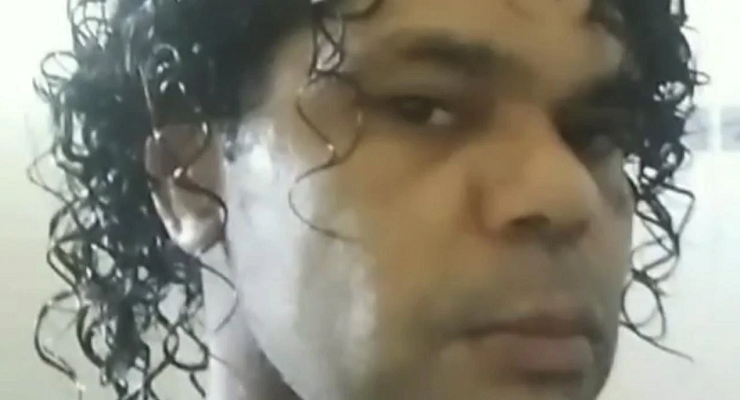
In America they call it the perp walk, the public parading of a person under arrest on their way from one place of detention to another (or to or from court) under obvious restraints. There is much debate about whether it is a positive representation of transparency in the criminal justice process — nobody is above the law — or a flagrant infringement of rights designed to, and tending to, prejudice the likelihood of a fair trial.
It has been far less common in Australia, where police and prison authorities have managed to find better ways to get a person from the door of a building into a van without having to walk them past a bank of reporters and cameras (and sometimes a baying mob).
So it was a little unusual to see the widespread media coverage of Terence Kelly — the Western Australian man accused of kidnapping four-year-old Cleo Smith, a story that had captivated the nation during the 18 days she was missing — being walked to a plane by police. Kelly, understandably, looked bedraggled; more importantly, he was barefoot and shackled with handcuffs and leg irons.
The consequence, some very senior lawyers in WA believe, is that Kelly’s case has been rendered “untriable”. The prejudicial effect of the images, which we can assume have been seen by at least everyone in the state from which a jury would be drawn if he is brought to trial, has been said to “make trial by jury almost an impossibility”.
The lawyers are invoking a longstanding legal principle, which says that pre-trial publicity can, if it’s bad enough, make it actually impossible for the state to provide what the rule of law guarantees: a fair trial attended by the presumption of innocence. There is a point at which prospective jurors are so inevitably infected by the prejudicial impact of what they’ve seen and heard that we simply cannot have faith in their ability to put all that to one side and deal with the prosecution case on its merits.
The courts have always been wary of going overboard on this principle, giving juries a (probably unjustified) very wide benefit of doubt about their openness of mind. Sometimes they will issue orders to positively suppress pre-trial publicity when it’s getting out of control, but this particular horse has well and truly bolted.
The images of Kelly are confronting per se, and inevitably position him in even the least easily influenced brain as a criminal. Because he is an Indigenous person, and in WA, the abstract risk of prejudice becomes all the more real.
Leg shackles evoke a deep wound; as Greens Senator Lidia Thorpe described it, the imagery and memory of shackling are “burned, ingrained, into our soul and our hearts and our identity as blak people in this country”.
It is a historical fact that shackling Indigenous people like animals — in the middle of last century the use of neck shackles was still widespread in the Northern Territory and WA — is a part of our shared memory of the discriminatory application of police process. It is a fact that Indigenous people continue to be wildly disproportionately arrested and imprisoned by our system, in WA more than any other jurisdiction.
These factors compound the particular prejudice that Kelly faces. His chances of a fair jury trial, following the intense media reportage of both the hunt and the apparently bizarre aspects of his life, look pretty slim.
There is another problem: nobody knows whether he is even fit to stand trial. As far as I know, he has not had a mental health assessment, and it may well be that he will end up being handled within the mental health system rather than the criminal justice one. Speculation on that, as with any aspects of what he did or didn’t do, is unhelpful and damaging.
Still, the relentlessness of the modern media cycle and the pervasiveness of social media mean that the boundaries of sensitivity have largely gone the way of the dinosaurs; we have lost the knack for waiting for anything to be resolved by due process.
If Kelly ends up facing trial, it may be before a judge alone, on the basis that a jury trial is adjudged to be not a fair option. That is for the courts to decide, and I’ll place my faith in them getting that call right.
What the case should teach us is that our culture of instant gratification places more, not less, responsibility on those who hold the instruments of state power to wield them with ever more care. The use of leg irons should be reconsidered; the use of perp walks too.
No good is served by the state pandering to the voyeuristic desires of the crowd, lest the crowd become a lynch mob.








Many thanks for your article, Michael. I’m surprised few else in the media drew attention to Kelly’s shackling; I was disgusted to see it – parading white victory over black criminals as it were. Moreover, the girl was apparently unharmed. This needs to be further pursued and WA’s punitive and callous stance towards Indigenous people exposed.
The WA police could have spent $20 at the op shop and clothed him better. Handcuffed, only, to an Officer and treated humanely, i.e. not paraded for the media. WA Police undoing some of their good PR for finding Cleo and reverting to type. They just can’t help themselves. Barefoot and shackled? ****!!!!!!!
One of the early acts of the the current ACT Chief Magistrate was to chide police for bringing a defendant before the Court dressed in a disposable jumpsuit because their clothes had been seized for forensic testing. Cops weren’t impressed, but she was determined that defendants were entitled to a modicum of dignity.
Crikey, what purpose did the Facebook image of the guy in question at the head of this article serve? Just wondering …
Thanks for making that clear, it was horrifying footage. I will also be interested to see any further debate about the police role.
In NSW there are a number of cases which look very dubious; one cannot afford to say more than that without a lawyer to check it.
I would like to reassure Michael Bradley that I am a white Western Australian and I, like everyone I have spoken to about this, was horrified to see this poor man shackled and photographed. I don’t believe a local jury would be prejudiced by the publicity – rather it took the shine off the police. However, if legal opinion is different I support whatever is the fairest and most compassionate process in this particular case.